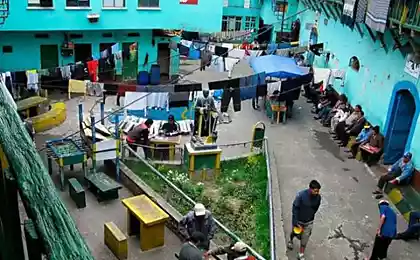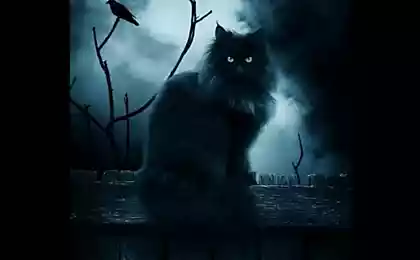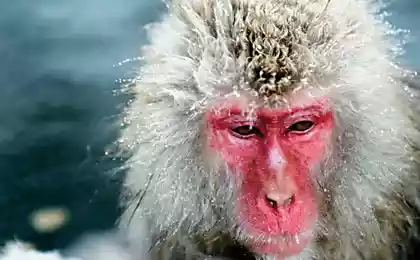799
Japanese delicacies for thrill-seekers
Not everyone would dare to try at least one of the dishes presented in the continuation of the post ... look.
1. "Shirak" Milk
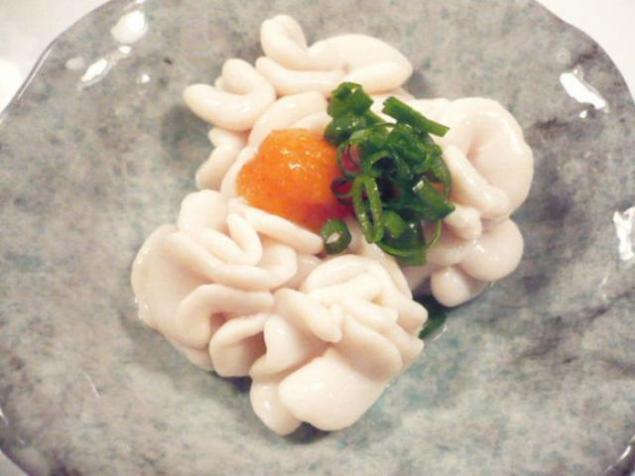
With Japanese sounds like "Shirak" - nothing more than the male equivalent of caviar. If caviar is fish eggs, the "Shirak" is the seminal fluid. The taste of "Shirak" as cream or whipped cream. Methods for preparing diverse - you can put out, fry in a pan or deep-fried. But in spite of the opportunities in cooking this dish, nothing will save you from awkward silence among friends, when you let them know that eating in Japan.
2. puffer fish

Some may have heard that this fish contains the poison, the largest concentration of deadly substances is precisely in the liver. This is probably the only fish, which need to touch very professional. Usually fugu served raw thinly sliced - sashimi, or stewed with vegetables. In fact, in modern history it is not recorded so many deaths from puffer fish. The most famous people who died of it, was an actor Bando Mitsugoro, it happened in 1975. Many will tell you that attracts this dish not the taste that is quite bland and did not cause any excitement, but a state of awe that you defied death.
3. "Ikizukuri." Live sashimi
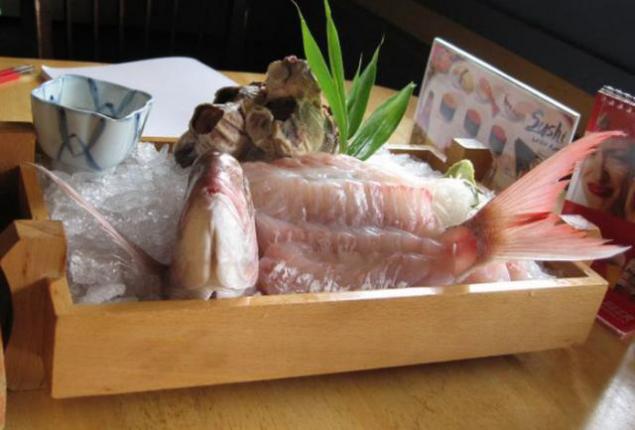
This dish is definitely not for the faint of heart, as it is commonly prepared from live fish, shrimp or lobster. And when you are served sashimi, your dish is still alive. It is believed that in this way the food looks more fresh, the same applies to the taste. Needless to say, feast on the fish, watching her die in front of you, the effect is not pleasant.
4. "Funazuashi." Fermented sushi

Funazuashi - a dish of Japanese carp, which is marinated in rice for four years. Fermented fish slicing and serving as sushi. This is one of the oldest ways to cook sushi, which is still used in the area of Shiga Prefecture. As you could imagine, the smell of this dish is incredibly sharp, and tastes pretty sour.
5. "Cugir". Whale meat

Despite the opinion of the international community, "in the name of science," the Japanese are still annual whaling, whose meat, in part, are openly sold in local markets. And to everyone's surprise, it is one of the common meals in schools, but it is not very common in restaurants. You might think that the whale meat is just amazing, given such rapid resentment towards whaling, but I dare to disappoint you, the taste is a bit deflating. Therefore, in the school canteen was often fried in deep fat.
6. "Tobias." Flying fish roe

If you are a true fan of sushi, you probably are familiar with multi-colored eggs of flying fish. And if you manage to try the fish itself? Her lean meat, and it is quite easy to use, but you need to be extremely cautious: this fish is very sharp wings.
7. "Ankimo." Monkfish liver

Despite the terrifying appearance of the liver being considered the best delicacy in Japan, whose taste compared with foie gras. The liver serves a spicy sauce ponzu, previously rubbed with salt and rice wine oprysnuv.
8. "dried apricots". Medusa

Usually, jellyfish zasushivat first, because without water, it quickly deteriorates. Before submitting it is soaked in water and sprayed vinegar. Some argue that there are jellyfish same as chewing gum, and someone compares it with boiled squid. In itself it is tasteless, so the key to success lies solely in the sauce.
9. "Shishamo." Smelt

Or shishamo - fish length of 15 centimeters, which is fried and eaten whole. It is often cooked for lunch in the school canteen where children try to grab as much as possible, "the pregnant females," plenty to eat caviar.
10. "Shiokara." Fermented fish entrails.

Preparing a dish of fermented crushed internal organs of various marine animals. Definitely a dish to taste not for everyone. What can we say about us? Even the Japanese themselves by his side.
11. "Hoya". Marine pineapple

This strange creature seemed pulled from science fiction film. Taste is also very unusual, to match the appearance. Even in Japan, this dish is rarely where you can meet. Usually it is made and served to the sashimi sake.
12. "saz". Horned sea snail

If you happen to be walking along the beach in the summer, you will see how horny fried sea snails. They can also be eaten raw, extending from the bottom of the shell black, bitter taste snail.
13. "Kegani." Hairy crab.

The taste is no different from their counterparts, and that it makes it unique is the look.
14. "Uni". The gonads of sea urchin
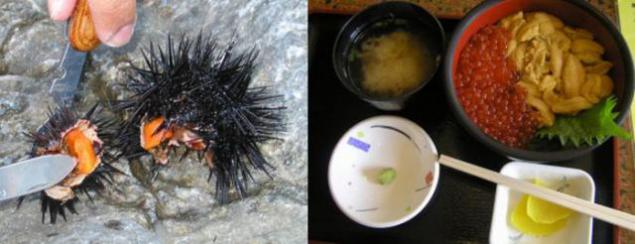
Sea urchin - another horrible sea creature with a delicious secret inside. The gonads of the sea urchin is eaten raw, after removing the barbed shell. They have a salty, almost creamy taste, and can be sold to the highest bidder.
15. "Chirimen Dzyak." Pickles dried sardines or anchovies

If you prefer to eat a hundred fish at a time, then this is for you. Young anchovies or sardines are usually placed on top of rice and mixed vegetables. On the palate it is very salty, but very edible.
16. "Abalon»

Although this creature looks more like a clam, yet Abalon is a species of sea snail and, thanks to its chewing texture and crisp taste, is considered a delicacy in Japan. They can be supplied in the form of sashimi and fried.
17. "Namak". Sea cucumber

It is usually eaten raw or under vinegar sauce. It is believed that the sea cucumber is very "refined taste", but some will not agree with it, calling it too bland.
18. "Mentayko." Marinated cod or pollock roe

This dish came to Japan from Korea and is considered one of the most favorite among the locals. Pickled eggs with spices so popular that it is added in almost everything from spaghetti to rice balls and mayonnaise. In Japan, there are even chips with similar taste.
19. "Shiroyuo but odorigui." Dancing frozen fish

These transparent small fish are eaten alive, and on the feeling that they are dancing in your mouth. They are virtually all previously described food, tasteless, so they are literally bathed in soy sauce and eaten with a spoon.
20. "Kamenote." Japanese shells

Literally a Japanese delicacy that is translated as "turtle foot" because of her strong resemblance. The taste may seem a little harsh, and before you start eating, you should make sure that the shell is completely removed.
21. "Qusayy." Dried fish in the company's Japanese-style
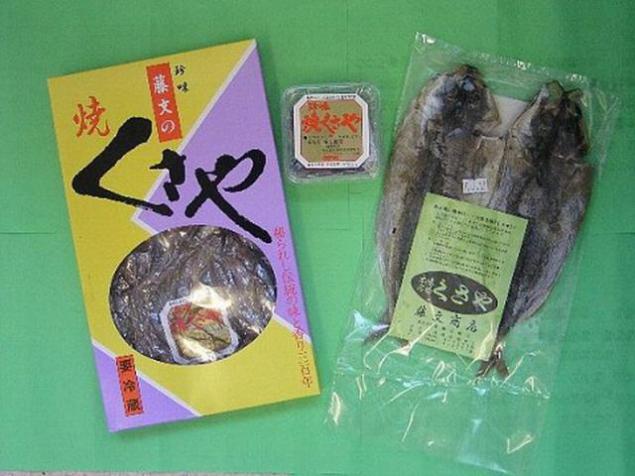
During the preparation of this delicacy used such fish as mackerel, it is soaked in salt water for about 20 hours and then dried for several days in the sun. Some manufacturers are proud to share the same sea brine for several generations. Although the smell must have just blows everything in its path, but the taste of the fish becomes quite soft.
From
1. "Shirak" Milk

With Japanese sounds like "Shirak" - nothing more than the male equivalent of caviar. If caviar is fish eggs, the "Shirak" is the seminal fluid. The taste of "Shirak" as cream or whipped cream. Methods for preparing diverse - you can put out, fry in a pan or deep-fried. But in spite of the opportunities in cooking this dish, nothing will save you from awkward silence among friends, when you let them know that eating in Japan.
2. puffer fish

Some may have heard that this fish contains the poison, the largest concentration of deadly substances is precisely in the liver. This is probably the only fish, which need to touch very professional. Usually fugu served raw thinly sliced - sashimi, or stewed with vegetables. In fact, in modern history it is not recorded so many deaths from puffer fish. The most famous people who died of it, was an actor Bando Mitsugoro, it happened in 1975. Many will tell you that attracts this dish not the taste that is quite bland and did not cause any excitement, but a state of awe that you defied death.
3. "Ikizukuri." Live sashimi

This dish is definitely not for the faint of heart, as it is commonly prepared from live fish, shrimp or lobster. And when you are served sashimi, your dish is still alive. It is believed that in this way the food looks more fresh, the same applies to the taste. Needless to say, feast on the fish, watching her die in front of you, the effect is not pleasant.
4. "Funazuashi." Fermented sushi

Funazuashi - a dish of Japanese carp, which is marinated in rice for four years. Fermented fish slicing and serving as sushi. This is one of the oldest ways to cook sushi, which is still used in the area of Shiga Prefecture. As you could imagine, the smell of this dish is incredibly sharp, and tastes pretty sour.
5. "Cugir". Whale meat

Despite the opinion of the international community, "in the name of science," the Japanese are still annual whaling, whose meat, in part, are openly sold in local markets. And to everyone's surprise, it is one of the common meals in schools, but it is not very common in restaurants. You might think that the whale meat is just amazing, given such rapid resentment towards whaling, but I dare to disappoint you, the taste is a bit deflating. Therefore, in the school canteen was often fried in deep fat.
6. "Tobias." Flying fish roe

If you are a true fan of sushi, you probably are familiar with multi-colored eggs of flying fish. And if you manage to try the fish itself? Her lean meat, and it is quite easy to use, but you need to be extremely cautious: this fish is very sharp wings.
7. "Ankimo." Monkfish liver

Despite the terrifying appearance of the liver being considered the best delicacy in Japan, whose taste compared with foie gras. The liver serves a spicy sauce ponzu, previously rubbed with salt and rice wine oprysnuv.
8. "dried apricots". Medusa

Usually, jellyfish zasushivat first, because without water, it quickly deteriorates. Before submitting it is soaked in water and sprayed vinegar. Some argue that there are jellyfish same as chewing gum, and someone compares it with boiled squid. In itself it is tasteless, so the key to success lies solely in the sauce.
9. "Shishamo." Smelt

Or shishamo - fish length of 15 centimeters, which is fried and eaten whole. It is often cooked for lunch in the school canteen where children try to grab as much as possible, "the pregnant females," plenty to eat caviar.
10. "Shiokara." Fermented fish entrails.

Preparing a dish of fermented crushed internal organs of various marine animals. Definitely a dish to taste not for everyone. What can we say about us? Even the Japanese themselves by his side.
11. "Hoya". Marine pineapple

This strange creature seemed pulled from science fiction film. Taste is also very unusual, to match the appearance. Even in Japan, this dish is rarely where you can meet. Usually it is made and served to the sashimi sake.
12. "saz". Horned sea snail

If you happen to be walking along the beach in the summer, you will see how horny fried sea snails. They can also be eaten raw, extending from the bottom of the shell black, bitter taste snail.
13. "Kegani." Hairy crab.

The taste is no different from their counterparts, and that it makes it unique is the look.
14. "Uni". The gonads of sea urchin

Sea urchin - another horrible sea creature with a delicious secret inside. The gonads of the sea urchin is eaten raw, after removing the barbed shell. They have a salty, almost creamy taste, and can be sold to the highest bidder.
15. "Chirimen Dzyak." Pickles dried sardines or anchovies

If you prefer to eat a hundred fish at a time, then this is for you. Young anchovies or sardines are usually placed on top of rice and mixed vegetables. On the palate it is very salty, but very edible.
16. "Abalon»

Although this creature looks more like a clam, yet Abalon is a species of sea snail and, thanks to its chewing texture and crisp taste, is considered a delicacy in Japan. They can be supplied in the form of sashimi and fried.
17. "Namak". Sea cucumber

It is usually eaten raw or under vinegar sauce. It is believed that the sea cucumber is very "refined taste", but some will not agree with it, calling it too bland.
18. "Mentayko." Marinated cod or pollock roe

This dish came to Japan from Korea and is considered one of the most favorite among the locals. Pickled eggs with spices so popular that it is added in almost everything from spaghetti to rice balls and mayonnaise. In Japan, there are even chips with similar taste.
19. "Shiroyuo but odorigui." Dancing frozen fish

These transparent small fish are eaten alive, and on the feeling that they are dancing in your mouth. They are virtually all previously described food, tasteless, so they are literally bathed in soy sauce and eaten with a spoon.
20. "Kamenote." Japanese shells

Literally a Japanese delicacy that is translated as "turtle foot" because of her strong resemblance. The taste may seem a little harsh, and before you start eating, you should make sure that the shell is completely removed.
21. "Qusayy." Dried fish in the company's Japanese-style

During the preparation of this delicacy used such fish as mackerel, it is soaked in salt water for about 20 hours and then dried for several days in the sun. Some manufacturers are proud to share the same sea brine for several generations. Although the smell must have just blows everything in its path, but the taste of the fish becomes quite soft.
From












